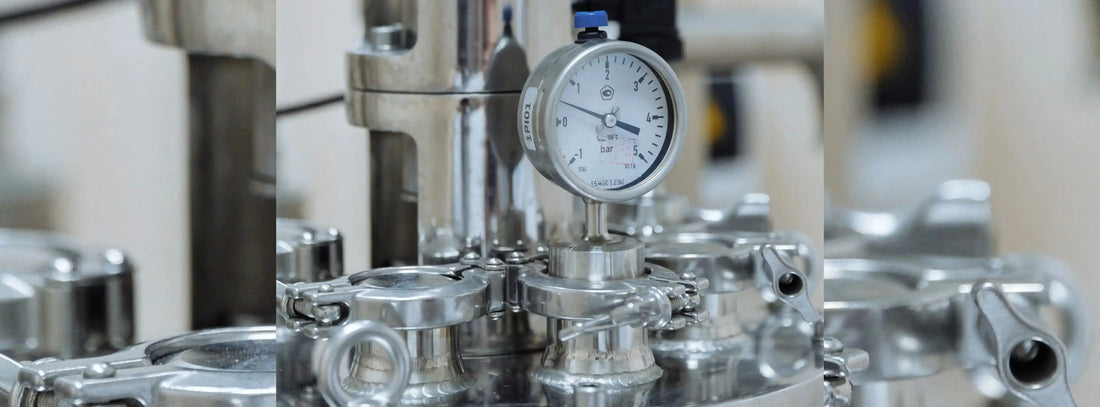Abstract: Briefly introduce the precautions of diaphragm pressure gauge in practical application for reference by practitioners. Keywords: Mechanism principle of diaphragm pressure gauge; Diaphragm pressure gauge calibration; Diaphragm pressure gauge application
The diaphragm pressure gauge consists of a diaphragm isolator and a general purpose pressure gauge. It is a diaphragm gauge of a system. It is suitable for measuring the pressure of the medium with strong corrosion, high temperature, high viscosity, easy crystallization, easy solidification, solid floating matter, and the direct measurement of the medium must be avoided. Access to general purpose pressure gauges and situations where it is easy to prevent deposits from accumulating. Diaphragm pressure gauges are mainly used for the pressure of fluid media in the production process of petrochemical, alkali production, chemical fiber, dyeing, pharmaceutical, food and cheese production.
How it works
The diaphragm pressure gauge is composed of a diaphragm isolator and a general-purpose pressure gauge. The diaphragm seals the diaphragm. When the pressure P of the measured medium acts on the diaphragm, it deforms and compresses the working fluid filled in the system, so that the working fluid forms a ΔP equivalent to P, with the help of work.
The conduction of the liquid makes the free end of the elastic element (spring tube) in the pressure instrument produce corresponding elastic deformation-displacement, and then the measured pressure value is displayed according to the working principle of the pressure instrument matched with it.
Temperature characteristics of diaphragm pressure gauge: Since the diaphragm pressure gauge system is filled with sealing liquid as the medium for transmitting pressure, due to the temperature expansion coefficient of the sealing liquid, the indication of the pressure gauge increases as the temperature of the pressure-receiving part increases. The amount of temperature influence is related to the expansion coefficient of the sealing body, the stiffness of the diaphragm and the pressure temperature, especially for the pressure instrument with low range. Generally, the temperature error of the pressure-receiving part is not more than 0.1%/°C, so the total temperature effect of the diaphragm pressure gauge is generally the sum of the temperature effect of the general-purpose instrument and the temperature effect of the pressure-receiving part of the diaphragm device.
Calibration of the diaphragm pressure gauge
Before installing the diaphragm pressure gauge, you must carefully check the model, diaphragm material, and measuring range to check whether the diaphragm is bumped; when there is no pressure, the pressure gauge indicates whether it is at the zero position, and at the same time, find out the reason, re-adjust, calibrate It can only be used after passing the inspection. The steps for calibrating a diaphragm pressure gauge are the same as those for calibrating a conventional pressure gauge, and will not be repeated again. The following points are mainly noted:
(1) Before calibration, according to the diaphragm device model of the diaphragm pressure gauge to be calibrated, prepare a matching joint so that it can be used in a general pressure calibration bench. The diaphragm device of the diaphragm pressure gauge is generally flanged. Prepare matching pressure joints according to the size and model of the flange. You can find the corresponding flanges and general pressure gauge joints for processing on site, which is also the most direct and convenient method.
(2) Pay attention in the process of fixing the calibrated diaphragm pressure gauge on the standard calibration bench: handle it with care, and do not bruise the diaphragm. When rotating the calibrated diaphragm pressure gauge with a wrench, the wrench must be stuck in the The connecting nut of the diaphragm device is not stuck on the general pressure gauge, because the general pressure gauge and the diaphragm device on the instrument are the same. And it will affect the performance or even scrap it, especially for new students who have just joined the work. Before checking the female force table, this must be explained clearly.
(3) Results processing: In the process of boosting, compare with the standard table, if it is out of tolerance, first check whether there are problems such as oil leakage and sealing. If the above situation is not the case, then you can remove the indicator needle and reset the indicator needle. Long-term experience is that it is reasonable to choose 1/2 of the range to reset the needle when setting the needle; if it is still out of tolerance, it can only be downgraded or scrapped.
Applications of Diaphragm Pressure Gauge
Before using and installing a diaphragm pressure gauge, be sure to clarify the characteristics of the medium to be monitored, because the diaphragm pressure gauge is specially designed for special media. When monitoring general gas, water and oil pressure, general pressure gauges can be selected. When monitoring the pressure of nitric acid, phosphoric acid and strong alkali, a stainless steel pressure gauge can be selected. But when the monitored medium is highly corrosive, such as hydrochloric acid, wet chlorine, ferric chloride; or has high viscosity, such as latex; easy to crystallize, such as salt water; easy to solidify, such as hot asphalt; solid floatings, such as sewage, etc., it is not acceptable to use the above pressure gauge. Because the SUS316 stainless steel pipe will be corroded by hydrochloric acid, the floating substance of asphalt and sewage will also block the pressure guide hole of the pressure gauge, and the pressure gauge will lose its function. Since the diaphragm pressure gauge has a diaphragm, it can prevent the medium with high viscosity, easy crystallization and solidification from flowing into the pressure guide hole, so as to ensure that the reading of the pressure gauge can normally reflect the pressure of the measured medium.
The following points should be paid attention to when using the diaphragm pressure gauge:
(1) The installation position of the diaphragm pressure gauge must correspond to the installation position in the precautions in the pressure gauge instruction manual.
(2) The pressure gauge should select the appropriate interface form, diaphragm material and gasket material according to the properties of the measured medium. When used in the occasions with strong mechanical vibration and medium pressure pulsation, it is required to use a shock-resistant pressure gauge. When the pressure gauge is put into operation under pressure, the valve should be opened slowly and evenly.

